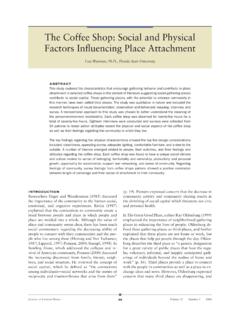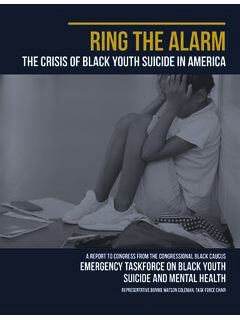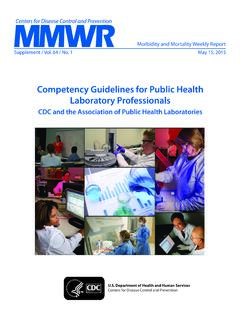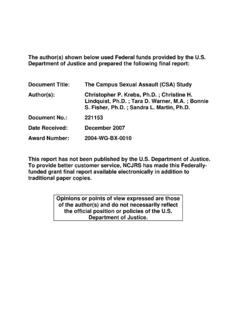Transcription of The Coffee Shop: Social and Physical factors Influencing ...
1 The Coffee Shop: Social and Physical factors Influencing Place Attachment Lisa Waxman, , Florida State University Abstract This study explored the characteristics that encourage gathering behavior and contribute to place attachment in selected Coffee shops in the context of literature suggesting Social gathering places contribute to Social capital. These gathering places, with the potential to enhance community in this manner, have been called third places. The study was qualitative in nature and included the research techniques of visual documentation, observation and behavioral mapping, interview, and survey.
2 A transactional approach to this study was chosen to better understand the meaning of the person-environment relationship. Each Coffee shop was observed for twenty-five hours for a total of seventy-five hours. Eighteen interviews were conducted and surveys were collected from 94 patrons to reveal patron attitudes toward the Physical and Social aspects of the Coffee shop as well as their feelings regarding the community in which they live. The key findings regarding the Physical characteristics showed the top five design considerations included: cleanliness, appealing aroma, adequate lighting, comfortable furniture, and a view to the outside.
3 A number of themes emerged related to people, their activities, and their feelings and attitudes regarding the Coffee shop. Each Coffee shop was found to have a unique Social climate and culture related to sense of belonging, territoriality and ownership, productivity and personal growth, opportunity for socialization, support and networking, and sense of community . Regarding feelings of community , survey findings from Coffee shops patrons showed a positive correlation between length of patronage and their sense of attachment to their community .
4 Introduction (p. 19). Putnam expressed concern that the decrease in Researchers Unger and Wandersman (1985) discussed community activity and community sharing results in the importance of the community to the human Social , the shrinking of Social capital which threatens our civic emotional, and cognitive experiences. Rivlin (1987) and personal health. explained that the connections to community create a bond between people and place in which people and In The Great Good Place, author Ray Oldenburg (1999).
5 Place are molded into a whole. Although the value of emphasized the importance of neighborhood gathering place and community seems clear, there has been much places in enhancing the lives of people. Oldenburg de- Social commentary regarding the decreasing ability of fined these gathering places as third places, and further people to connect with their communities and the peo- explained that these places are not home or work, but ple who live among them (Fleming and Von Tscharner, the places that help get people through the day.)
6 Olden- 1987; Lippard, 1997; Putnam, 2000: Stumpf, 1998). In burg describes the third place as a generic designation Bowling Alone, which addressed the collapse and re- for a great variety of public places that host the regu- vival of American community , Putnam (2000) discussed lar, voluntary, informal, and happily anticipated gath- the increasing disconnect from family, friends, neigh- erings of individuals beyond the realms of home and bors, and Social structure. He reviewed the concept of work (p.
7 16). Third places provide a place to connect Social capital, which he defined as the connections with the people in communities as well as a place to ex- among individuals Social networks and the norms of change ideas and news. However, Oldenburg expressed reciprocity and trustworthiness that arise from them concern that many third places are disappearing, and Journal of Interior Design 35 Volume 31 Number 3 2006. The Coffee Shop: Social and Physical factors Influencing Place Attachment Waxman The experience of place is unique to each individual and is directly related to his or her lived experiences.
8 Attachment to place is a set of feelings that emotionally binds people to a particular place. that in the United States, the third place has become This research on place and place attachment points to a distant third. He raised the question of how this de- the value of place in the lives of people. This paper will crease in the availability of community gathering places expand on this research by exploring the variables that impacts the lives of people. What are the consequences contribute to gathering behavior and place attachment when communities lack places to gather with neigh- in third places, specifically Coffee shops.
9 The sites cho- bors, friends, and to mingle with the familiar strangers sen for study included three selected Coffee shops in a who hold the potential for new friendships, relation- mid-size city in the southeastern United States. The pur- ships, and ultimately the growth of the Social capital in pose of this study was to see what qualities, both physi- a community ? cal and Social , encourage people to gather in those cof- fee shops and develop an attachment to those places. Oldenburg (1999) explained that most third places draw their identity from the beverages they serve.
10 His- Literature Review torically, Coffee houses have provided places for Social Due to the availability of literature on the Social /psy- intercourse and conversation, as well as political debate chological studies of place, and a lack of literature on (Pendergrast, 1999). They have also served as places the design of Social gathering places, this review of liter- where people could gather, speak freely, and mingle with ature will focus primarily on studies of place and place others from their communities (Oldenburg, 1999).






